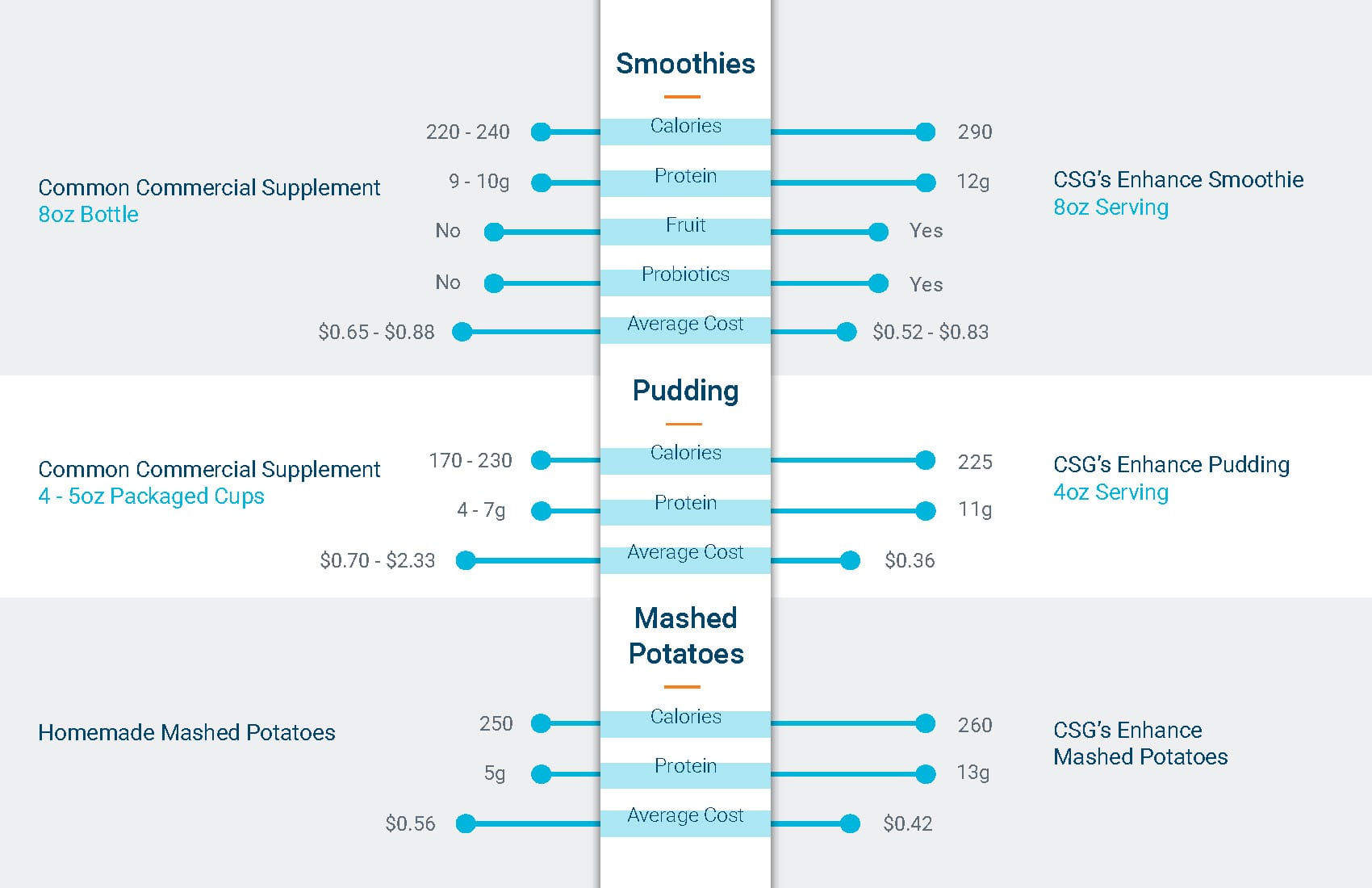Last updated on June 15th, 2023
Malnourishment is a common problem in senior living communities across the country. In fact, up to 50% of the hospitalized elderly population are malnourished, and about 16% of community-dwelling Americans older than 65 consume fewer than 1,000 calories per day.
The World Health Organization defines malnutrition as “deficiencies, excesses or imbalances in a person’s intake of energy and/or nutrients.” The term “malnutrition” can refer to people who are either undernourished or overnourished.
One of the most common ways to combat malnutrition in senior living communities is with commercially made supplements. However, we believe that there is another way. A food-first approach to nutrition is about using real food to increase caloric intake and nutritional value to help malnourished residents.
Why Are So Many Seniors Malnourished?
One of the big reasons seniors might be malnourished is because of therapeutic diet treatments. Therapeutic diets are created to increase or decrease the intake of various foods in order to treat specific conditions, like hypertension or diabetes. These diets typically come with a lot of restrictions about what a person can and can’t eat.
Some seniors may be malnourished because of an inability to eat due to various conditions like dementia, muscle weakness, or dysphagia. And sometimes medication to treat conditions can also cause malnutrition because of the side effects that make them not want to eat. Side effects of certain medications include dry mouth, a reduced appetite, altered taste, nausea, vomiting, and diarrhea.
Another reason seniors may be malnourished is because of their senses. As people get older, their senses, like smell and vision, might dull. This may mean that food doesn’t look as appetizing to people, so they won’t eat it.
What About Supplements?
As we mentioned above, commercially made supplements are one of the most common ways to treat malnutrition in seniors. Supplements come in many forms and are commonly served to seniors as pills or supplement powders that are added to certain foods, like smoothies. While supplements make a lot of claims, medical researchers haven’t really been able to prove that supplements are beneficial. Instead, a healthy, balanced diet should be able to provide seniors with the nutrition they need.
The Food-First Approach to Malnutrition
A 2016 study set out to find if enriched foods could help improve meals and combat malnutrition instead of supplements. The study found that “food-based fortification yielded positive results in the total amount of ingested calories and protein.” A fortified diet refers to when additional nutrients are added to meals through certain ingredients.
A fortified, enriched, and liberalized diet can be a lower-cost way for your dining program to fight malnutrition in your community. Liberalized diets are the person-centered care alternative to therapeutic, restrictive diets. Liberalized diets aim to provide seniors with the food they actually like, while still keeping them healthy. This may mean that a patient gets a smaller portion of their favorite sweet treat or only get to eat red meat a few times a month, but they’re still getting the food they want sometimes rather than having to eliminate it altogether.
A food-first approach to combating malnutrition means that your dining program might increase meal frequency, increase the number of courses you serve at each meal, provide more snacks between meals, and infuse food with real ingredients (not supplement powders) to boost nutrition and energy, like oil, honey, and juice.
For example, you could fortify mashed potatoes with cream or butter. If you’re serving meat as a main course, consider adding cheese, gravy, or another sauce to create a more nutrient-dense plate. Sauces and soups are some of our favorite foods to fortify because you can “hide” a variety of nutritious foods in them, like fish, fruits, and vegetables. You can also still serve your residents smoothies, but take out the supplement powder and replace it with ingredients like greek yogurt, peanut butter, and extra fruits and veggies.
How Culinary Services Group Fights Malnutrition
Culinary Services Group follows the person-centered, food-first approach to fighting malnutrition. We recently hosted a low-vision meal workshop at one of our communities. This lunch focused on brightly colored foods that would appeal to seniors with dulling senses and used many recipes in our Empower Finger Foods program.
- Berry Custard Cups
- Western Egg Bites
- German Potato Salad Croquettes
- Pasta Salad Stuffed Shells and Summer Cous Cous Sweet Peppers
When it comes to fortified foods, we recognize that they only work if residents eat them. That’s why we developed our Enhance program. The Enhance Premium Program provides residents with delicious, enriched foods to promote weight gain or weight maintenance. The Enhance program fortifies familiar foods like hot cereals, potatoes, and soups with natural, wholesome ingredients.
We’ve found that this food-first approach has been proven to be more cost-effective than traditional commercial supplements. Our real food approach costs less while providing similar or better caloric and protein intake.

With this program, our Registered Dietitians work with residents to determine a meal plan strategy based on diet, food preferences, ordered liquid consistency, and other nutritional challenges. In the kitchen, Food Service Directors and Chef Managers work to ensure recipes are crafted with consistency and nutritional adequacy.
When communities select this program, Culinary Services Group makes sure that we choose a cook for your community who is passionate about fortified foods. We also provide continued training at our corporate kitchen headquarters with our executive chef. By providing foods that are familiar favorites, we set our goals to nourish your community and improve the quality of life for those we serve.
If you’d like to learn more about the Enhance premium program (or any of our other premium programs), feel free to contact us here.












